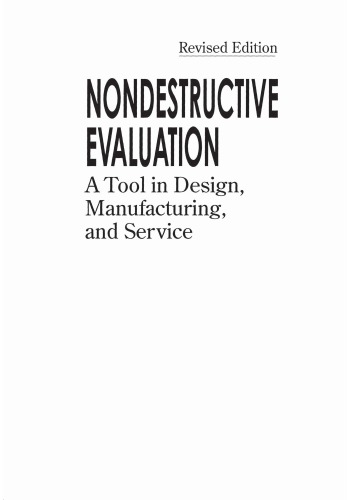Nondestructive evaluation a tool in design manufacturing and service First Edition by Don Bray, Roderick Stanley 9781351989510 1351989510
$50.00 Original price was: $50.00.$35.00Current price is: $35.00.
Nondestructive evaluation a tool in design manufacturing and service First Edition by Don Bray, Roderick Stanley – Ebook PDF Instant Download/Delivery: 9781351989510, 1351989510
Full download Nondestructive evaluation a tool in design manufacturing and service First Edition after payment

Product details:
ISBN 10: 1351989510
ISBN 13: 9781351989510
Author: Don Bray, Roderick Stanley
Nondestructive evaluation (NDE) inspection schemes are important in design, manufacturing, and maintenance. By correctly applying techniques of NDE, we can reduce machine and system failures and increase reliability of operating systems over an extended lifetime. Nondestructive Evaluation: A Tool in Design, Manufacturing, and Service introduces and discusses primary techniques used in the field, including ultrasonics, acoustic emission, magnetics, radiography, penetrants, and eddy currents. Examples of each of these techniques are included, demonstrating typical applications.
Nondestructive evaluation a tool in design manufacturing and service First Table of contents:
PART I Probability, Design, and Management in Nondestructive Evaluation
1 NDE in Design, Maintenance and Service
1-1 Introduction
1-2 Benefits of NDE
1-3 Visual Inspections
1-4 Choosing the NDE Technique
1-5 Human Factors
1-6 Qualifications of NDE Personnel
1-7 Summary
2 Probability Applications in Nondestructive Evaluation
2-1 Introduction
2-2 Probability in Nondestructive Evaluation
2-3 Probability Events and Combinations
2-4 Probability Sample Spaces and Flaw Size Distributions
2-5 Conditional Probability
2-6 Effect of Inspection on Flaw Size Distribution
2-7 Data Set Characteristics
2-8 Summary
3 Nondestructive Evaluation in Design
3-1 Introduction
3-2 NDE in Design for Performance
3-3 Design for Inspectability
3-4 Failure Rate, Reliability, and NDE
3-5 Flaw Characteristics and NDE
3-6 Fracture Mechanics and NDE
3-7 Summary
4 Inspection Optimization Using Probabilistic Criteria
4-1 Introduction
4-2 Probability of Detection
4-3 Cost and Benefit Analysis for NDE in Manufacturing and Maintenance
4-4 Probabilistic NDE Decisions
4-5 Risk-Based Inspection
4-6 Retirement for Cause
4-7 Summary
Problems
References
PART II Ultrasonic Techniques in Nondestructive Evaluation
5 Elastic Wave Propagation
5-1 Introduction
5-2 One-Dimensional (Plane) Waves
5-3 Bulk Waves
5-4 Particle Motion, Wave Fronts, Wavelength, Frequency, and Wave Speed
5-5 Reflection and Refraction at Interfaces
5-5.1 Normal Incidence
5-5.2 Oblique Incidence
5-6 Pulse Characteristics—Dispersion
5-7 Attenuation and Scattering
5-8 Temperature Effect on Wave Speeds in Solids
5-9 Summary
6 Wave Propagation in Guided Wave Modes
6-1 Introduction
6-2 Surface (Rayleigh) Waves
6-3 Waves in Plates, Bars, and Rods
6-4 Leaky Lamb Waves
6-5 Summary
7 Ultrasonic Circuitry and Transducers
7-1 Introduction
7-2 Piezoelectric Transducers
7-3 Ultrasonic Circuitry for Piezoelectric Transducers
7-4 Transducer Characteristics
7-5 Beam Characteristics
7-6 Focused Probes
7-7 Electromagnetic-Acoustic (EMAT) Probes
7-8 Laser Generation and Reception of Ultrasound
7-9 Array Transducers
7-10 Discussion and Summary
8 Inspection Principles and Techniques
8-1 Introduction
8-2 Normal Incidence Pulse–Echo Inspection
8-3 Normal Incidence Piich–Catch Inspection
8-4 Angle Beam Pulse-Echo Inspection
8-4.1 Shear Wave Angle Beam Inspection
8-4.2 Longitudinal Wave Angle Beam Inspection
8-5 Angle Beam, Pitch-Catch Inspection
8-6 Criteria for Probe Selection
8-6.1 Flaw Size Sensitivity
8-6.2 Beam Divergence
8-6.3 Penetration
8-6.4 Resolution
8-7 Operation of Ultrasonic Inspection Instruments
8-8 Techniques for Normal Beam Ultrasonic Inspection
8-8.1 Fatigue Cracks
8-8.2 Inclusions, Slag, Porosity, and Large Grain Structure
8-8.3 Press Fits
8-8.4 Spurious Reflections at Fillets on Machined Shafts
8-8.5 Long Bars and Inertial Welds
8-8.6 Effects of Material Structure on Ultrasonic Inspection
8-8.7 Attenuation Measurement
8-8.8 Thickness Measurements
8-8.9 Detection of Corrosion and Hydrogen Attack
8-9 Techniques for Angle Beam Ultrasonic Inspection
8-9.1 Inspection for Planar Cracks Using Angle Beam Probes
8-9.2 Weld Inspection
8-9.3 Detection of Corrosion and Hydrogen Attack
8-9.4 Pipe Inspection
8-10 Techniques for Surface Wave Inspections
8-11 Inspection with Lamb Waves
8-12 Surface and Near-Surface Inspections Using Critically Refracted Waves
8-12.1 Inspecting Layered Material Using Higher-Order Rayleigh Waves
8-13 Flaw Sizing and Characterization
8-13.1 Amplitude Down Methods
8-13.2 Time-of-Flight (Diffraction) Techniques
8-13.3 Ultrasonic Sizing of Small Flaws with the Distance-Amplitude-Correction (DAC) Curve
8-13.4 Comparison of Ultrasonic Flaw Detection and Sizing Methods
8-14 Flaw Imaging
8-14.1 B-scan
8-14.2 C-scan
8-15 Immersion Testing
8-16 Squirters and Wheel Transducers
8-17 Through-Transmission with Air Propagation Transducers
8-18 Frequency Analysis Techniques
8-19 Summary
9 Ultrasonic Techniques for Stress Measurement and Material Studies
9-1 Introduction
9-2 Ultrasonic Stress Measurement Techniques
9-2.1 Theoretical Background
9-2.2 Experimental Measurement of Acoustoelastic Constants
9-2.3 Changes in Wave Travel-Time Associated with Varying Elastic Properties
9-2.4 Force Measurement with LCR Waves
9-2.5 Using the Empirical, Zero Force Time-Base for Applied Force Measurement
9-2.6 Ultrasonic Stress Measurement in Welded Plates
9-2.7 Summary
9-3 Application of the LCR Technique for Evaluating Nodularity and Residual Stresses in Ductile Cast Iron
9-4 Wave Velocity Changes in Textured Crystalline Materials
9-4.1 Effect of Preferred Orientation (Texture) on Wave Speed
9-4.2 Ultrasonic Determination of Preferred Orientation
9-4.3 Summary
9-5 Grain Size Determination Using Ultrasonic Pulse Scattering
9-6 Characterization of Composite Materials
9-7 Summary
Problems
References
PART III Acoustic Emission Techniques in Nondestructive Evaluation
10 Acoustic Emission Principles
10-1 Introduction
10-2 Sources
10-2.1 AE Source in Steels
10-2.2 AE Signal Intensity in Metals and Alloys
10-2.3 AE Signal Intensity in FRP Composite Material
10-2.4 AE Signals in Concrete
10-2.5 AE Signals from Tanks and Containers
10-3 Characteristics of AE Signals
10-3.1 Kaiser and Felicity Effects
10-3.2 Wave Propagation Characteristics
11 Data Collection and Analysis Techniques
11-1 AE Sensors
11-2 Signal Parameters
11-3 Data Quality Analyses
11-3.1 Instrumentation
11-3.2 System Calibration
11-3.3 Source Location Schemes
11-3.4 Characterizing Emission Sources
12 Applications of Acoustic Emission in NDE
12-1 Pressure Vessels
12-2 Railroad Tank Cars
12-3 Inspection of Bridges
12-4 Damage Evaluation Using Acousto-Ultrasonics
12-5 Other Applications
Problems
References
PART IV Magnetic Flux Leakage Techniques in Nondestructive Evaluation
13 Basic Magnetism for NDE
13-1 Introduction
13-2 General Physical Units
13-3 The Magnetic Pole
13-4 Lines of Force
13-5 Magnetic Flux Density (B)
13-6 Magnetic Field Intensity (H)
13-7 Magnetic Field Intensity Due to a Bar Magnet
13-8 Pole Concept in NDE
13-9 Magnetic Moment
13-10 The Magnetic Dipole
13-11 Magnetic Effects of Steady Currents
13-11.1 Magnetic Field Intensity Due to a Current in a Straight Wire
13-11.2 Magnetic Field Intensity Due to a Current Loop
13-11.3 Magnetic Field Intensity on the Axis of a Coil
13-11.4 Magnetic Field Intensity Due to a Helmholtz Pair
13-11.5 Magnetic Field Intensity of a Solenoidal Coil
13-11.6 The Ring Solenoid
14 Magnetism in Materials
14-1 Introduction
14-2 Magnetization
14-3 Diamagnctism
14-4 Paramagnetism
14-5 Ferromagnetism
14-5.1 Rowland Ring Method
14-5.2 General Results from Rowland Ring Test
14-5.3 Specific Results for Some Ferromagnetic Materials
14-5.4 Explanation of Ferromagnetism—The Domain Theory
14-5.5 Domain Arrangements at Various States of Magnetism
14-5.6 Ferromagnetic Alloys
14-6 Ferrimagnetism
14-7 Measurements of the Magnetic Properties of Materials
14-8 Magnetic Permeability
14-9 Range of Magnetic Parameters in NDE
14-10 Magnet Materials and Transformer Steels
14-11 Measurement of Loss of Cross-Sectional Area of Tubes and Rods
15 Macroscopic Field Relations
15-1 Introduction
15-2 Magnetization and Amperian Current Distributions
15-3 Magnetic Field Produced by a Magnetic Material
15-4 Magnetic Pole Density
15-5 Magnetic Field Density
15-6 Ampere’s Circuital Law
15-6.1 Magnetic Field Intensity Inside and Outside a Straight Wire
15-6.2 Modification to Include Magnetic Material
15-6.3 Magnetization of Tubes by the Current Method
15-7 Susceptibility and Permeability
15-8 Magnetic Boundary Conditions
15-8.1 Continuity of Flux
15-8.2 Discontinuous Nature of H
15-8.3 Continuity of Normal Component of Β
15-8.4 Tangential Surface Boundary Condition
15-8.5 Static Permeability Relation
16 The Magnetic Circuit
16-1 Introduction
16-2 Toroid of Differing Materials
16-3 Magnetic Circuit of a Permanent Magnet
16-4 Residually Magnetized Slit Ring
16-4.1 Comparison with Experiment
16-5 Demagnetization Field
16-6 Demagnetization Factor Curves
16-7 Apparent Permeability
16-8 Apparent Permeability of Very Short Parts
16-9 Effect of the Demagnetizing Field
16-10 Coil Magnetization of Short Parts
16-11 Magnetic Circuits Used in Inspection
16-11.1 Elongated Tubes and Rods
16-11.2 Wire Rope Inspection
16-11.3 Internal Casing, Tubing, and Line Pipe Inspection
16-11.4 Ends of Tubes and Rods
16-11.5 Local Yoke Magnetization
16-11.6 Yokes in Rail Inspection
16-12 Other Flux Loop Applications
17 Magnetism in the Circumferential Direction
17-1 Introduction
17-2 Current Applied to the Part
17-3 The Internal Conductor Method
17-3.1 Central Conductor Method
17-3.2 Capacitor Discharge Magnetization
17-3.3 Flux Density Within Tube Wall
17-3.4 Multiple Pulsing
17-3.5 Conductor Offcentering
17-4 Yoke or Part Rotation Method
17-4.1 Eddy Currents in Rotating Yoke Inspection
17-4.2 Tube Inspection
18 Field Levels in Magnetic NDE
18-1 Introduction
18-2 Leakage Fields from a Slot
18-3 Surface Inspection—Active Field
18-4 Surface Inspection—Residual Induction
18-5 Subsurface Inspection—Active Field
18-6 Subsurface Inspection—Residual Induction
18-7 Causes of Surface Noise
18-7.1 Examples of Surface Noise
19 Magnetic Flux Leakage from Tight Flaws
19-1 Introduction
19-2 Angle of Applied Field to Flaw
19-3 Basic Förster Theory for a Through Slit
19-3.1 Magnetic Circuit for a Through Slit
19-3.2 The Magnetic Leakage Field Around the Through Slit
19-4 Karlqvist’s Equations for a Through Slit
19-5 Leakage Field Theories for a Finite Slot
19-5.1 Förster’s Theory
19-5.2 Theory of Zatsepin and Shcherbinin
19-5.3 Depressed Dipole Model
19-6 Comments on Dipole Theories for Perpendicular Slots
19-7 Comparison with Test Data
19-8 Measured Variations for Slot Depth and Width
19-9 Classical MFL Theory for Oblique Surface Flaws
20 Magnetic Flux Leakage from Subsurface Flaws
20-1 Introduction
20-2 Subsurface Cylindrical Hole
20-2.1 Predictions
20-2.2 Comparison with Experimental Results
20-3 Subsurface Spherical Inclusion
20-3.1 Predictions
20-3.2 Comparison with Experimental Results
21 Magnetic Flux Leakage Sensors
21-1 Introduction
21-2 The Hall Element
21-2.1 Theory
21-2.2 Manufacture and Sensitivity
21-2.3 Typical Applications
21-3 The Magnetodiode
21-3.1 Theory
21-3.2 Typical Application
21-4 Magnetic Recording Tape
21-4.1 Theory
21-4.2 Typical Application
21-5 The Pick-Up Coil
21-5.1 The Straight Wire
21-5.2 The Perpendicular Coil
21-5.3 Application of Perpendicular Coils in Tube Inspection
21-5.4 The Parallel Coil
21-5.5 Applications of Parallel Coils
21-5.6 Advantages and Disadvantages of Coils
21-6 The Förster Microprobe
21-6.1 Theory
21-6.2 Examples of Microprobe Use
21-7 The Magnetic Particle
21-7.1 Current Requirements for MPI
21-7.2 Forces on Particles
21-7.3 Particle Size and Testing
21-7.4 Use of Ultraviolet Light
21-7.5 Specialized Applications
21-7.6 Magnetic Particle Surface Field Indicators
22 Demagnetization
22-1 Introduction
22-2 Circumferential Remagnetization
22-3 Alternating Current Demagnetization
22-4 Direct Current Coil Demagnetization
22-5 Flux Sensed Demagnetization
22-6 Demagnetization of Irregularly Shaped Parts
Problems
References
Projects
PART V Eddy Current Techniques in Nondestructive Evaluation
23 Fundamental Eddy Current Concepts
23-1 Introduction
23-2 Equipment Requirements
23-3 Generation and Detection of Eddy Currents
23-4 Nature of Eddy Currents
23-5 Standard Penetration Depth and Phase Lag
23-6 Effective Depth of Penetration
24 Eddy Current Detector Parameters
24-1 Introduction
24-2 Coil Sensors
24-2.1 Coil Resistance
24-2.2 Variation of Resistance with Temperature
24-2.3 Variation of Resistance with Frequency
24-2.4 Coil Inductance
24-2.5 Coil Inductive Reactance
24-2.6 Total Coil Impedance
24-3 Single Test Coil Reactance Near Nonmagnetic and Magnetic and Materials
24-3.1 Lift Off Effects
24-3.2 Cup-Core and Shielded Probes
24-4 Encircling and Inner Diameter Coils
24-4.1 Encircling Absolute Coils
24-4.2 Internal Absolute Coils
24-4.3 Encircling Differential Coils
24-4.4 Internal Differential Coils
24-4.5 Dependence of Signal on Fill-Factor
24-5 Probe Arrays
25 Remote Field Eddy Current Techniques
25-1 Introduction
25-2 Schmidt Experiment
25-3 Explanation of the Effect
25-3.1 Example Using Phase Analysis
25-4 Detected Signal Strength
25-5 Applications of RFEC
25-5.1 Casing Equipment Design
25-5.2 Determination of Stuck Point
25-5.3 Heat Exchanger and Boiler Inspection
26 Impedance Plane Diagrams
26-1 Introduction
26-2 Voltage Plane Analysis for a Constant Voltage Circuit
26-3 Normalization
26-3.1 Nonmagnetic Parts
26-3.2 Ferromagnetic Parts
26-4 Characteristic Frequency
26-5 Concept of Effective Permeability
26-6 Examples of the Use of Impedance Plane Diagrams for Cylindrical Objects
26-6.1 Bars, Rods, Wires (Solid)
26-6.2 Thin-walled Tubes
26-6.3 Thick-walled Tubes
26-7 Surface Current Densities in Tube Inspection
26-8 Surface Field Intensity Ratios in Tube Inspection
26-9 Crack Signal Analysis on Complex Plane for Bars and Tubes
26-10 Concept of Transmission Coefficient
26-11 Impedance Plane for Through Transmission Testing
26-12 Impedance Plane for Probe Coil Analyses
26-13 Conductivity and Lift Off Measurements
26-13.1 General Comments
26-13.2 Conductivity Measurements
26-13.3 Thickness Meaurements
26-13.4 Thickness of Nonconductive Layers
26-13.5 Thickness of Conductive Layers
26-13.6 Impedance Plane for Cracks in Nonmagnetic Materials with a Probe Coil
26-14 Magnetic Permeability Used in Eddy Current Testing
27 Eddy Current Instrumentation
27-1 Conductivity and Wall Thickness
27-1.1 Background to Conductivity Measurements
27-1.2 Aluminum Properties
27-1.3 Lift-Off Effects
27-1.4 Single Phasorscope Units
27-1.5 Dedicated Instruments
27-1.6 Dual Frequency Measurement of Τ and σ
27-1.7 Absolute Method with Through Transmission Testing
27-2 Crack Detection
27-2.1 Dedicated Instruments
27-2.2 Phasorscope Instruments
27-2.3 Differential Method
27-2.4 Bolthole Inspection
27-3 Hysteresis Loop Analysis
27-4 Multifrequency Tests
27-5 Steel Inspection Applications
27-5.1 Hot Steel Inspection
27-5.2 Roll Inspection
27-5.3 Magnetizing Field Strength Effects
Problems
References
Projects
PART VI Radiographic Techniques in Nondestructive Evaluation
28 Principles of Radiation
28-1 Introduction
28-2 Basic Principles of Radiographic Inspection
28-3 Physics of Radiographic NDE
28-4 Electromagnetic Radiation Sources
28-4.1 Gamma Ray Sources
28-4.2 Characteristics of X-ray Sources
28-5 Particle Sources
28-5.1 Thermal Neutron Sources
28-5.2 Proton Sources
28-6 Geometric Unsharpness
28-7 Intensity Change with Distance
28-8 Absorption and Scattering of Radiation Energy
28-8.1 Structure of Crystalline Materials
28-8.2 Scattering Mechanisms for Electromagnetic Radiation
28-8.3 Scattering Mechanisms for Particle Radiation
28-9 Secondary Radiation
28-9.1 Broad-Beam and Narrow-Beam Geometry
28-9.2 Build-up Factor
28-10 Summary
29 Radiographic Imaging
29-1 Introduction
29-2 Radiographic Images
29-3 Image Recording
29-3.1 Film Radiography
29-3.2 Real-Time Radiography (Radioscopy) and Image Data Analysis
29-3.3 Radiographic Tomography
29-4 Source-lo-Film Distance
29-5 Determining Radiographic Exposure
29-6 Radiographic Sensitivity
29-7 Evaluating Image Quality and Sensitivity
29-8 Summary
30 Radiographic Inspection Systems
30-1 Introduction
30-2 Filters and Screens
30-3 Typical Source Handling Device for Isotopes
30-4 X-Ray Machines
30-5 Real Time Radiography System
30-6 Neutron Particle Machines
30-7 Proton Sources
30-8 Radiographic Inspection Facilities
30-9 Summary
31 Radiographic Inspections
31-1 Introduction
31-2 Radiographic Appearance of Commonly Occurring Anomalies
31-3 Inspection of Uniform Flat Sections
31-4 Inspection of Circular Sections
31-5 Inspection of Irregular Shapes
31-6 Effects of Material Property Variations on Radiographic Inspections
31-7 Summary
32 Other Applications of Radiography in NDE
32-1 Introduction
32-2 Inspections Using Computed Tomography (CT)
32-3 Microfocus and Real-Time Radiography
32-4 Flash Radiography
32-5 Electron Radiography
32-6 Inspection with Thermal Neutrons
32-7 Inspection with Protons
32-8 Material Investigations Using Diffraction Techniques
32-8.1 X-ray Measurement of Stress
32-8.2 Material Studies Using Radiographic Techniques
32-9 Summary
33 Safety Considerations in Radiographic Inspections
33-1 Introduction
33-2 Radiation Exposure and Dosage
33-3 Radiation Monitoring
33-4 Protection of Work Spaces
33-5 Licensing of Radiographic Work
33-6 Summary
Problems
References
PART VII Penetrant Techniques in Nondestructive Evaluation
34 Principles of Penetrants
34-1 Introduction
34-2 Principles of Fluid Mechanics on Surfaces
34-2.1 Surface Tension
34-2.2 Capillarity
34-3 Optical Principles in Defect Recognition
34-3.1 Visible Light Spectrum
34-3.2 Fluorescence and Ultraviolet Lighting
34-3.3 Laser Scanners
34-4 Background Control—Contrasts
34-5 Material Properties Affecting Penetrant Inspection
34-6 Summary
35 Techniques for Penetrant Inspection
35-1 Introduction
35-2 Basic Techniques for Penetrant Inspection
35-3 Penetrant Materials and Processes
35-3.1 Penetrants
35-3.2 Cleaners and Emutsifiers
35-3.3 Developers
35-4 Defect Recognition
35-4.1 Visible Dye Penetrants
35-4.2 Penetrant Brilliance
35-4.3 Visual Scan—Lighting and Detection
35-4.4 Automated Scan—Lighting and Detection
35-5 Typical Penetrant Indications
35-6 Temperature Effects on Penetrant Inspection
35-7 Harmful Effects of Contiminants on High Strength and High Temperature Alloys
35-8 Summary
36 Penetrant Inspection Applications
36-1 Introduction
36-2 Penetrant Inspection Systems
36-2.1 Water Washable Method
36-2.2 Postemulsifiable Method
36-2.3 Solvent Removable Method
36-2.4 Work Stations for Penetrant Inspection
36-3 Inspection of Large Components and Piping
36-4 Inspection of Composites and Adhesively Bonded Structures
36-5 Leak Detection
36-6 Summary
37 Summary, Safety and Environmental Considerations
37-1 Introduction
37-2 Safety Considerations
37-2.1 Effects on Personnel
37-2.2 Fire and Explosion
37-2.3 Effect of Ultraviolet Light on the Human Eye
37-3 Environmental Effects of Penetrant Process Chemicals
37-4 Summary
Problems
References
Appendices
A Modeling and Analysis of Experimental Data
B Attenuation Coefficients for Selected Elements
C NDE Codes, Specifications, and Standards
Index
People also search for Nondestructive evaluation a tool in design manufacturing and service First:
nondestructive evaluation and quality control
nondestructive testing and evaluation
nondestructive testing and evaluation impact factor
nondestructive testing and evaluation scimago
nondestructive testing and evaluation abbreviation
Tags: Nondestructive evaluation, design, manufacturing, Don Bray, Roderick Stanley



